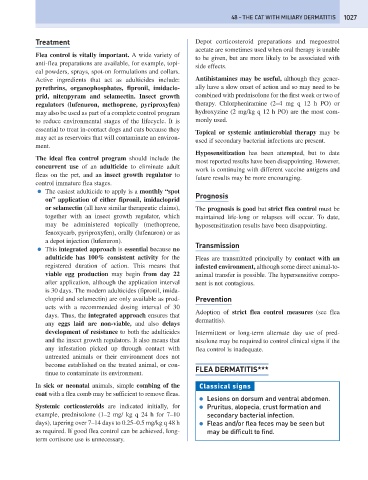Page 1035 - Problem-Based Feline Medicine
P. 1035
48 – THE CAT WITH MILIARY DERMATITIS 1027
Treatment Depot corticosteroid preparations and megoestrol
acetate are sometimes used when oral therapy is unable
Flea control is vitally important. A wide variety of
to be given, but are more likely to be associated with
anti-flea preparations are available, for example, topi-
side effects.
cal powders, sprays, spot-on formulations and collars.
Active ingredients that act as adulticides include: Antihistamines may be useful, although they gener-
pyrethrins, organophosphates, fipronil, imidaclo- ally have a slow onset of action and so may need to be
prid, nitenpyram and selamectin. Insect growth combined with prednisolone for the first week or two of
regulators (lufenuron, methoprene, pyriproxyfen) therapy. Chlorpheniramine (2–4 mg q 12 h PO) or
may also be used as part of a complete control program hydroxyzine (2 mg/kg q 12 h PO) are the most com-
to reduce environmental stages of the lifecycle. It is monly used.
essential to treat in-contact dogs and cats because they
Topical or systemic antimicrobial therapy may be
may act as reservoirs that will contaminate an environ-
used if secondary bacterial infections are present.
ment.
Hyposensitization has been attempted, but to date
The ideal flea control program should include the
most reported results have been disappointing. However,
concurrent use of an adulticide to eliminate adult
work is continuing with different vaccine antigens and
fleas on the pet, and an insect growth regulator to
future results may be more encouraging.
control immature flea stages.
● The easiest adulticide to apply is a monthly “spot
Prognosis
on” application of either fipronil, imidacloprid
or selamectin (all have similar therapeutic claims), The prognosis is good but strict flea control must be
together with an insect growth regulator, which maintained life-long or relapses will occur. To date,
may be administered topically (methoprene, hyposensitization results have been disappointing.
fenoxycarb, pyriproxyfen), orally (lufenuron) or as
a depot injection (lufenuron).
● This integrated approach is essential because no Transmission
adulticide has 100% consistent activity for the Fleas are transmitted principally by contact with an
registered duration of action. This means that infested environment, although some direct animal-to-
viable egg production may begin from day 22 animal transfer is possible. The hypersensitive compo-
after application, although the application interval nent is not contagious.
is 30 days. The modern adulticides (fipronil, imida-
cloprid and selamectin) are only available as prod- Prevention
ucts with a recommended dosing interval of 30
Adoption of strict flea control measures (see flea
days. Thus, the integrated approach ensures that
dermatitis).
any eggs laid are non-viable, and also delays
development of resistance to both the adulticides Intermittent or long-term alternate day use of pred-
and the insect growth regulators. It also means that nisolone may be required to control clinical signs if the
any infestation picked up through contact with flea control is inadequate.
untreated animals or their environment does not
become established on the treated animal, or con- FLEA DERMATITIS***
tinue to contaminate its environment.
In sick or neonatal animals, simple combing of the Classical signs
coat with a flea comb may be sufficient to remove fleas.
● Lesions on dorsum and ventral abdomen.
Systemic corticosteroids are indicated initially, for ● Pruritus, alopecia, crust formation and
example, prednisolone (1–2 mg/ kg q 24 h for 7–10 secondary bacterial infection.
days), tapering over 7–14 days to 0.25–0.5 mg/kg q 48 h ● Fleas and/or flea feces may be seen but
as required. If good flea control can be achieved, long- may be difficult to find.
term cortisone use is unnecessary.

